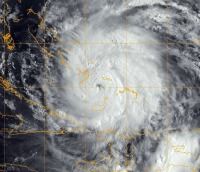BROOKE GLADSTONE:
No sooner had Hurricane Irene blown through the Eastern Seaboard than the backlash began. Hype, they cried! Irene was a bad storm but was it bad enough to justify all that coverage? Did we really need Geraldo Rivera's report on the hurricane preparedness of his own family?
GERALDO RIVERA:
My — our mom, 90 – almost 92-year-old mom is now at Craig’s house. He's a bit inland. She was with me. We evacuated her from big brother’s house to little brother’s house…
BROOKE GLADSTONE:
Howard Kurtz of The Daily Beast described the coverage as, quote, “A tsunami of hype,” though to be fair, he did note that it wasn't hype for the families who lost loved ones and the reporters who did good work.
But even TV news, blamed for most of the hurricane hype, got in on the anti-hype surge.
FEMALE CORRESPONDENT:
Was it worth all of the hype and wall-to-wall coverage, 24/7 on the mainstream media…
BROOKE GLADSTONE:
The New York Times’ statistically-driven blogger Nate Silver applied math to the question and found hype in the charges of hype.
NATE SILVER:
I was surprised to read columns by, for example, Howard Kurtz in The Daily Beast who’s a media critic there, who said, you know, oh this thing was, was overblown, it wasn't really a big deal. I mean, that didn't seem to square with the facts that it had caused a lot of damage and destruction.
And I think the combination of Howard Kurtz’ column being a little bit sanctimonious, on the one hand, and also, on the other hand, being just not [LAUGHS] really correct on the facts, if you try and objectively say how bad was this hurricane, how much damage did it cause, it ranked pretty high up the list.
BROOKE GLADSTONE:
So in trying to determine whether or not the early coverage of Irene was proportional with regard to whether there was hype, you actually broke down the coverage into something called news units. And can you describe what those are?
NATE SILVER:
So if 10 percent of the articles on a given day published in all the newspapers in the United States mentioned a storm, that counts as a news unit. So if some storms, for example, had as many as three or four news units’ worth of coverage, while they were still active, meaning that they basically dominated the news cycle for several days.
And with Irene the score was about two and half. Basically, it equates that two and a half days of kind of saturation. [LAUGHS] coverage, which is a lot.
BROOKE GLADSTONE:
Yeah, you said that Irene ranked 10th in news coverage from among the 92 named tropical storms that made landfall in the United States since 1980. Well, 10 out of 92 seems high. Do you think it deserved to rank at number 10?
NATE SILVER:
Well, how destructive was the storm? If you measure it by economic damage, there - concentrated around a number like 14 billion dollars, which would be quite high - adjusted for inflation, would be, I think, about eighth or ninth on the list of storms since 1980.
If you look at the loss of life, that's actually worse, where now you're up to about 45 overall fatalities. That might rank as high as third since 1980.
BROOKE GLADSTONE:
Irene ranked roughly third in terms of fatalities, roughly eighth in terms of property damage and it got the tenth most coverage among storms. So, if anything, under-hyped?
NATE SILVER:
You know, yeah. If anything, I, I suppose it was under-hyped relative to other hurricanes. But say that it had totally missed, right? Say that it had kind of swum off to the Atlantic Ocean and caused very little damage at all, you still had a storm that was very, very threatening. And we know from Katrina that when you have a storm which bears down on a major city, the risk of a catastrophic impact becomes much higher.
BROOKE GLADSTONE:
I mean, we're talking about coverage of a story that hasn't happened yet. And meteorology is not perfectly predictive, as we all know. So do you blame a media outlet for giving the best guess, in terms of the coverage, of serious consequences, even if they don't pan out?
NATE SILVER:
Any weather forecast has uncertainty. If it had been a Category 2, instead of a Category 1, you might have had four or five times as much damage to property. So you’d be talking about a 60- or 70-billion-dollar disaster.
If it had been a Category 3 storm that followed the same trajectory and was as big and slow as Irene was, then you're talking about probably a disaster in the hundreds of billions.
Do you want to talk about an over-hyped story, you know, like the DC-based earthquake, for example, that's an over-hyped story.
BROOKE GLADSTONE:
If you want hype –
[NATE LAUGHS]
- look to the earthquake.
NATE SILVER:
[LAUGHING] They’re – they’re a lot easier targets, I think, than a destructive hurricane, potentially. I'm not saying it's journalism at its finest, you know. And I think it would behoove news departments around the country to have, you know, journalists who are more versed in meteorology, right? To have a better understanding of that in the press counts I think would be useful, as well.
BROOKE GLADSTONE:
So there may be an expertise gap. But your numbers tell you there wasn't hype.
NATE SILVER:
Every story on cable news [LAUGHS] is hyped. But I think the coverage was proportionate, relative to the amount of damage the storm caused.
BROOKE GLADSTONE:
Nate, thank you very much.
NATE SILVER:
Yeah, thank you for having me on.
BROOKE GLADSTONE:
Nate Silver writes the 538 blog, which you can find at NYTimes.com
[MUSIC/MUSIC UP AND UNDER]
